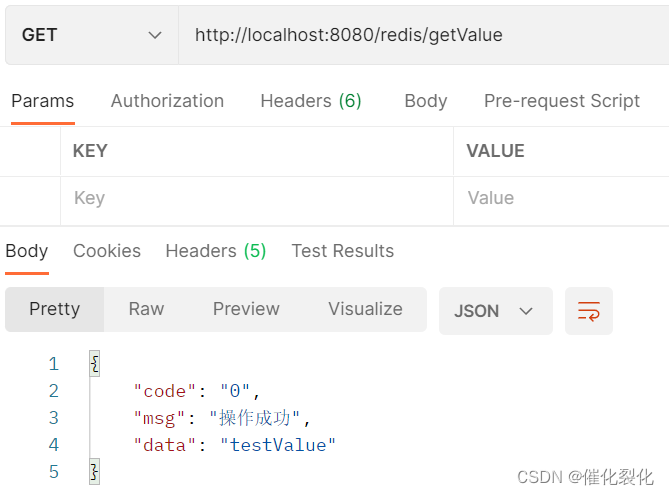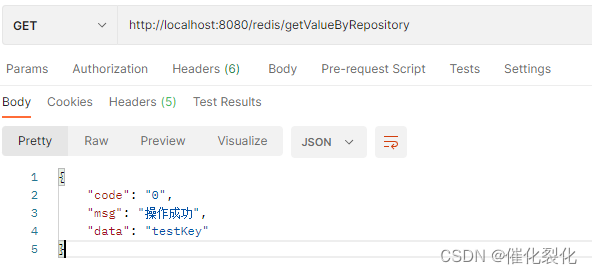SpringBoot项目中引入Redis
上一篇我们搭建了一个SpringBoot项目,这一节将介绍如何引入redis。2.添加连接配置3.测试连接编写一个简单的测试接口用postman测试上面步骤我们采用了RedisTemplate类来操作Redis,该类操作其它类型Redis数据的方法如下为了更简便操作Redis,我们一般重新封装RedisTemplate类。5.测试编写测试接口postman测试...
·
上一篇我们搭建了一个SpringBoot项目,这一节将介绍如何引入redis。
1.添加依赖
<!--集成redis-->
<dependency>
<groupId>org.springframework.boot</groupId>
<artifactId>spring-boot-starter-data-redis</artifactId>
<version>2.1.7.RELEASE</version>
</dependency>
<!--序列化-->
<dependency>
<groupId>com.alibaba</groupId>
<artifactId>fastjson</artifactId>
<version>1.2.54</version>
<scope>compile</scope>
</dependency>
2.添加连接配置
spring:
redis:
host: 127.0.0.1
3.测试连接
编写一个简单的测试接口
@RestController
@RequestMapping("redis")
public class RedisTestController {
@Autowired
RedisTemplate redisTemplate;
@GetMapping("getValue")
public Result getValue() {
redisTemplate.opsForValue().set("testKey", "testValue");
return Result.succ(redisTemplate.opsForValue().get("testKey"));
}
}
用postman测试

4.RedisTemplate
上面步骤我们采用了RedisTemplate类来操作Redis,该类操作其它类型Redis数据的方法如下
// redisTemplate #操作不同的数据类型,api和我们的指令是一样的
// opsForValue #操作字符串 类似String
// opsForList #操作List 类似List
// opsForSet #操作set
// opsForHash #操作hash
// opsForZSet #操作zset
// opsForGeo #操作geo
// opsForHyperLogLog #操作HyperLogLog
// 除了进本的操作,我们常用的方法都可以直接通过redisTemplate操作,比如事务,和基本的 CRUD
// 获取redis的连接对象
// RedisConnection connection = redisTemplate.getConnectionFactory().getConnection();
// connection.flushDb();
// connection.flushAll();
为了更简便操作Redis,我们一般重新封装RedisTemplate类。
@Slf4j
@Component
public class RedisRepository {
/**
* 默认编码
*/
private static final Charset DEFAULT_CHARSET = StandardCharsets.UTF_8;
/**
* value 序列化
*/
private static final JdkSerializationRedisSerializer OBJECT_SERIALIZER = new JdkSerializationRedisSerializer();
/**
* Spring Redis Template
*/
@Resource
private RedisTemplate<String, Object> redisTemplate;
/**
* 获取链接工厂
*/
public RedisConnectionFactory getConnectionFactory() {
return this.redisTemplate.getConnectionFactory();
}
/**
* 获取 RedisTemplate对象
*/
public RedisTemplate<String, Object> getRedisTemplate() {
return redisTemplate;
}
/**
* 清空DB
*
* @param node redis 节点
*/
public void flushDB(RedisClusterNode node) {
this.redisTemplate.opsForCluster().flushDb(node);
}
/**
* 添加到带有 过期时间的 缓存
*
* @param key redis主键
* @param value 值
* @param time 过期时间(单位秒)
*/
public void setExpire(final byte[] key, final byte[] value, final long time) {
redisTemplate.execute((RedisCallback<Long>) connection -> {
connection.setEx(key, time, value);
log.debug("[redisTemplate redis]放入 缓存 url:{} ========缓存时间为{}秒", key, time);
return 1L;
});
}
/**
* 添加到带有 过期时间的 缓存
*
* @param key redis主键
* @param value 值
* @param time 过期时间(单位秒)
*/
public void setExpire(final String key, final Object value, final long time) {
redisTemplate.execute((RedisCallback<Long>) connection -> {
RedisSerializer<String> serializer = getRedisSerializer();
byte[] keys = serializer.serialize(key);
byte[] values = OBJECT_SERIALIZER.serialize(value);
connection.setEx(keys, time, values);
return 1L;
});
}
/**
* 一次性添加数组到 过期时间的 缓存,不用多次连接,节省开销
*
* @param keys redis主键数组
* @param values 值数组
* @param time 过期时间(单位秒)
*/
public void setExpire(final String[] keys, final Object[] values, final long time) {
redisTemplate.execute((RedisCallback<Long>) connection -> {
RedisSerializer<String> serializer = getRedisSerializer();
for (int i = 0; i < keys.length; i++) {
byte[] bKeys = serializer.serialize(keys[i]);
byte[] bValues = OBJECT_SERIALIZER.serialize(values[i]);
connection.setEx(bKeys, time, bValues);
}
return 1L;
});
}
/**
* 一次性添加数组到 过期时间的 缓存,不用多次连接,节省开销
*
* @param keys the keys
* @param values the values
*/
public void set(final String[] keys, final Object[] values) {
redisTemplate.execute((RedisCallback<Long>) connection -> {
RedisSerializer<String> serializer = getRedisSerializer();
for (int i = 0; i < keys.length; i++) {
byte[] bKeys = serializer.serialize(keys[i]);
byte[] bValues = OBJECT_SERIALIZER.serialize(values[i]);
connection.set(bKeys, bValues);
}
return 1L;
});
}
/**
* 添加到缓存
*
* @param key the key
* @param value the value
*/
public void set(final String key, final Object value) {
redisTemplate.execute((RedisCallback<Long>) connection -> {
RedisSerializer<String> serializer = getRedisSerializer();
byte[] keys = serializer.serialize(key);
byte[] values = OBJECT_SERIALIZER.serialize(value);
connection.set(keys, values);
log.debug("[redisTemplate redis]放入 缓存 url:{}", key);
return 1L;
});
}
/**
* 查询在这个时间段内即将过期的key
*
* @param key the key
* @param time the time
* @return the list
*/
public List<String> willExpire(final String key, final long time) {
final List<String> keysList = new ArrayList<>();
redisTemplate.execute((RedisCallback<List<String>>) connection -> {
Set<String> keys = redisTemplate.keys(key + "*");
for (String key1 : keys) {
Long ttl = connection.ttl(key1.getBytes(DEFAULT_CHARSET));
if (0 <= ttl && ttl <= 2 * time) {
keysList.add(key1);
}
}
return keysList;
});
return keysList;
}
/**
* 查询在以keyPatten的所有 key
*
* @param keyPatten the key patten
* @return the set
*/
public Set<String> keys(final String keyPatten) {
return redisTemplate.execute((RedisCallback<Set<String>>) connection -> redisTemplate.keys(keyPatten + "*"));
}
/**
* 根据key获取对象
*
* @param key the key
* @return the byte [ ]
*/
public byte[] get(final byte[] key) {
byte[] result = redisTemplate.execute((RedisCallback<byte[]>) connection -> connection.get(key));
log.debug("[redisTemplate redis]取出 缓存 url:{} ", key);
return result;
}
/**
* 根据key获取对象
*
* @param key the key
* @return the string
*/
public Object get(final String key) {
Object resultStr = redisTemplate.execute((RedisCallback<Object>) connection -> {
RedisSerializer<String> serializer = getRedisSerializer();
byte[] keys = serializer.serialize(key);
byte[] values = connection.get(keys);
return OBJECT_SERIALIZER.deserialize(values);
});
log.debug("[redisTemplate redis]取出 缓存 url:{} ", key);
return resultStr;
}
/**
* 根据key获取对象
*
* @param keyPatten the key patten
* @return the keys values
*/
public Map<String, Object> getKeysValues(final String keyPatten) {
log.debug("[redisTemplate redis] getValues() patten={} ", keyPatten);
return redisTemplate.execute((RedisCallback<Map<String, Object>>) connection -> {
RedisSerializer<String> serializer = getRedisSerializer();
Map<String, Object> maps = new HashMap<>(16);
Set<String> keys = redisTemplate.keys(keyPatten + "*");
if (CollectionUtils.isNotEmpty(keys)) {
for (String key : keys) {
byte[] bKeys = serializer.serialize(key);
byte[] bValues = connection.get(bKeys);
Object value = OBJECT_SERIALIZER.deserialize(bValues);
maps.put(key, value);
}
}
return maps;
});
}
/**
* Ops for hash hash operations.
*
* @return the hash operations
*/
public HashOperations<String, String, Object> opsForHash() {
return redisTemplate.opsForHash();
}
/**
* 对HashMap操作
*
* @param key the key
* @param hashKey the hash key
* @param hashValue the hash value
*/
public void putHashValue(String key, String hashKey, Object hashValue) {
log.debug("[redisTemplate redis] putHashValue() key={},hashKey={},hashValue={} ", key, hashKey, hashValue);
opsForHash().put(key, hashKey, hashValue);
}
/**
* 获取单个field对应的值
*
* @param key the key
* @param hashKey the hash key
* @return the hash values
*/
public Object getHashValues(String key, String hashKey) {
log.debug("[redisTemplate redis] getHashValues() key={},hashKey={}", key, hashKey);
return opsForHash().get(key, hashKey);
}
/**
* 根据key值删除
*
* @param key the key
* @param hashKeys the hash keys
*/
public void delHashValues(String key, Object... hashKeys) {
log.debug("[redisTemplate redis] delHashValues() key={}", key);
opsForHash().delete(key, hashKeys);
}
/**
* key只匹配map
*
* @param key the key
* @return the hash value
*/
public Map<String, Object> getHashValue(String key) {
log.debug("[redisTemplate redis] getHashValue() key={}", key);
return opsForHash().entries(key);
}
/**
* 批量添加
*
* @param key the key
* @param map the map
*/
public void putHashValues(String key, Map<String, Object> map) {
opsForHash().putAll(key, map);
}
/**
* 集合数量
*
* @return the long
*/
public long dbSize() {
return redisTemplate.execute(RedisServerCommands::dbSize);
}
/**
* 清空redis存储的数据
*
* @return the string
*/
public String flushDB() {
return redisTemplate.execute((RedisCallback<String>) connection -> {
connection.flushDb();
return "ok";
});
}
/**
* 判断某个主键是否存在
*
* @param key the key
* @return the boolean
*/
public boolean exists(final String key) {
return redisTemplate.execute((RedisCallback<Boolean>) connection -> connection.exists(key.getBytes(DEFAULT_CHARSET)));
}
/**
* 删除key
*
* @param keys the keys
* @return the long
*/
public long del(final String... keys) {
return redisTemplate.execute((RedisCallback<Long>) connection -> {
long result = 0;
for (String key : keys) {
result = connection.del(key.getBytes(DEFAULT_CHARSET));
}
return result;
});
}
/**
* 获取 RedisSerializer
*
* @return the redis serializer
*/
protected RedisSerializer<String> getRedisSerializer() {
return redisTemplate.getStringSerializer();
}
/**
* 对某个主键对应的值加一,value值必须是全数字的字符串
*
* @param key the key
* @return the long
*/
public long incr(final String key) {
return redisTemplate.execute((RedisCallback<Long>) connection -> {
RedisSerializer<String> redisSerializer = getRedisSerializer();
return connection.incr(redisSerializer.serialize(key));
});
}
/**
* redis List 引擎
*
* @return the list operations
*/
public ListOperations<String, Object> opsForList() {
return redisTemplate.opsForList();
}
/**
* redis List数据结构 : 将一个或多个值 value 插入到列表 key 的表头
*
* @param key the key
* @param value the value
* @return the long
*/
public Long leftPush(String key, Object value) {
return opsForList().leftPush(key, value);
}
/**
* redis List数据结构 : 移除并返回列表 key 的头元素
*
* @param key the key
* @return the string
*/
public Object leftPop(String key) {
return opsForList().leftPop(key);
}
/**
* redis List数据结构 :将一个或多个值 value 插入到列表 key 的表尾(最右边)。
*
* @param key the key
* @param value the value
* @return the long
*/
public Long in(String key, Object value) {
return opsForList().rightPush(key, value);
}
/**
* redis List数据结构 : 移除并返回列表 key 的末尾元素
*
* @param key the key
* @return the string
*/
public Object rightPop(String key) {
return opsForList().rightPop(key);
}
/**
* redis List数据结构 : 返回列表 key 的长度 ; 如果 key 不存在,则 key 被解释为一个空列表,返回 0 ; 如果 key 不是列表类型,返回一个错误。
*
* @param key the key
* @return the long
*/
public Long length(String key) {
return opsForList().size(key);
}
/**
* redis List数据结构 : 根据参数 i 的值,移除列表中与参数 value 相等的元素
*
* @param key the key
* @param i the
* @param value the value
*/
public void remove(String key, long i, Object value) {
opsForList().remove(key, i, value);
}
/**
* redis List数据结构 : 将列表 key 下标为 index 的元素的值设置为 value
*
* @param key the key
* @param index the index
* @param value the value
*/
public void set(String key, long index, Object value) {
opsForList().set(key, index, value);
}
/**
* redis List数据结构 : 返回列表 key 中指定区间内的元素,区间以偏移量 start 和 end 指定。
*
* @param key the key
* @param start the start
* @param end the end
* @return the list
*/
public List<Object> getList(String key, int start, int end) {
return opsForList().range(key, start, end);
}
/**
* redis List数据结构 : 批量存储
*
* @param key the key
* @param list the list
* @return the long
*/
public Long leftPushAll(String key, List<String> list) {
return opsForList().leftPushAll(key, list);
}
/**
* redis List数据结构 : 将值 value 插入到列表 key 当中,位于值 index 之前或之后,默认之后。
*
* @param key the key
* @param index the index
* @param value the value
*/
public void insert(String key, long index, Object value) {
opsForList().set(key, index, value);
}
}
5.测试
编写测试接口
@RestController
@RequestMapping("redis")
public class RedisTestController {
@Autowired
RedisRepository redisRepository;
@GetMapping("getValueByRepository")
public Result getValueByRepository() {
redisRepository.set("testKey", "testKey");
return Result.succ(redisRepository.get("testKey"));
}
}
postman测试

更多推荐
 已为社区贡献2条内容
已为社区贡献2条内容









所有评论(0)